Asus ROG Strix Scar 15 (2022) Review
Can this exciting gaming notebook deliver the goods?
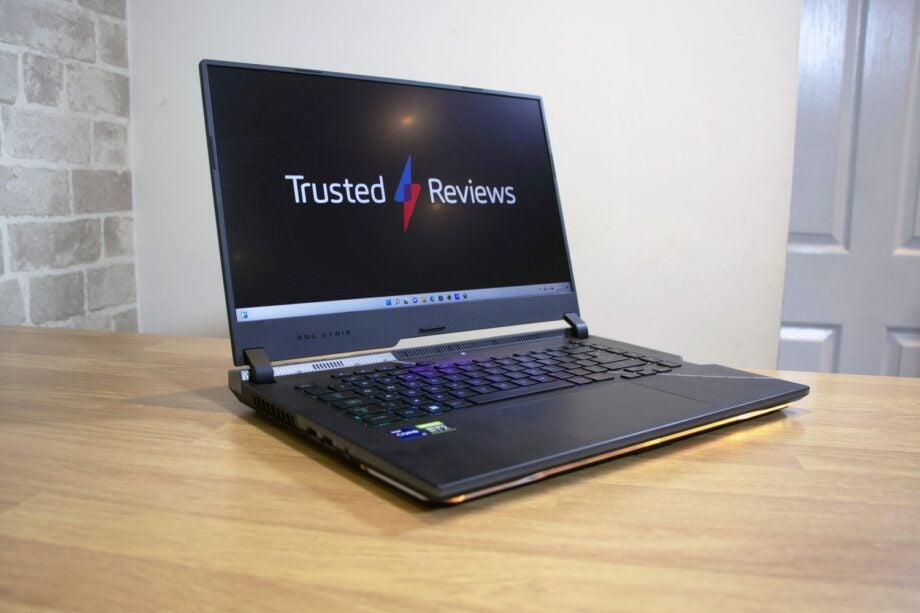
Verdict
The Asus ROG Strix Scar 15 is fast, it’s got a fantastic display, and it has a great keyboard inside a bold, RGB-covered chassis. That said, its rivals often have slimmer, sleeker designs, better connectivity and more screen options. This is a good laptop if you want a bold gaming machine, but other machines are more mature.
Pros
- Consistently good performance
- A superb 240Hz display
- Great keyboard
- Loads of RGB LED lighting
Cons
- Some GPU power issues
- Several missing features
- Heavier and thicker than rivals
- No 360Hz display option
Availability
- UKRRP: £2399
- USARRP: $2049
- EuropeRRP: €2799
Key Features
- Lashings of high-end powerAsus has included an Nvidia GeForce RTX 3070 Ti and Intel Core i9-12900H in this laptop, so you’ve got loads of power for any gaming situation and any tough creative workload.
- A high-quality displayThe panel’s 240Hz refresh rate is ample for most gaming situations and the resolution of 2560 x 1440 delivers sharp, crisp gameplay – and quality is consistently great too.
- Eye-catching designThe Scar is covered with RGB LEDs, and Asus includes translucent plastic and extra customisation options if you’d like to make this machine your own.
Introduction
The Asus ROG Strix Scar 15 is the boldest laptop in the eye-catching Asus gaming range, and the bevy of RGB LEDs and translucent plastic mean you’ll never mistake this notebook for anything else.
You’ll find plenty of high-end hardware underneath the gaudy looks, with graphical oomph coming from an Nvidia GeForce RTX 3070 Ti and processing power from Intel Alder Lake silicon.
To get all this gear, you’ll have to pay $2049 / £2399 / €2799, though, so the Scar has varying value in different markets – and it’s got strong competition from the Alienware x15 R2 and Razer Blade 15.
Design and Keyboard
- A chunky throwback design with bold looks and loads of RGB LEDs
- A crisp, robust keyboard with extra media keys
- Solid everyday connectivity but with plenty of missing features
The Asus ROG Strix Scar 15 is one of the most outlandish gaming laptops around today. You’ll find a ring of RGB LEDs underneath the base, and there’s more lighting in the lid and keyboard. Asus even crams a strip of lights into the cutaway section in the bottom of the display.
A swathe of the wrist-rest uses translucent plastic so gamers can glimpse circuit boards, and three interchangeable plastic panels attach to the hinge for some added customisation. I’d argue that the Asus looks like a throwback when compared to the monochrome Alienware and the sleek Razer Blade, but it’s certainly not subtle.
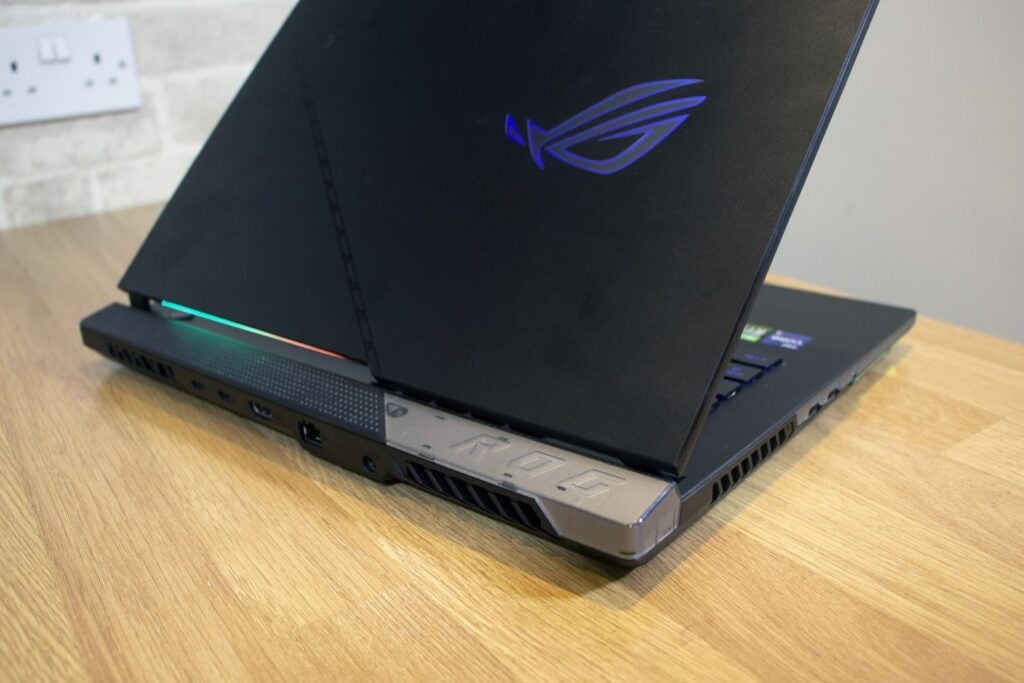
The Scar feels a bit retro in other areas, too. Its 2.3kg weight matches the Alienware, but its 27mm-thick body is chunky – its rivals are a centimetre thinner. At least build quality is good, and I’ve got no qualms about taking the robust ROG machine out of the house.
The Scar’s left-hand edge has two USB 3.2 Gen 1 ports and a headphone jack, and on the rear there’s a Thunderbolt 4 port, a Type-C connection with power delivery, and a future-proofed HDMI 2.1 output. The internal options are great, with 2.5Gbps Ethernet and dual-band Wi-Fi 6.
That’s enough connectivity for most gamers, but it could be better. Older Scar 15 models had one more full-size USB port, and the two that remain are very close together – attach a larger peripheral to one and you’ll block the other. Also bear in mind that other features are missing: this game-focussed portable has no webcam, card reader or biometric ability. It still has a notch for the Asus Keystone and its RFID attachments, but that feels like a gimmick and a waste of space.
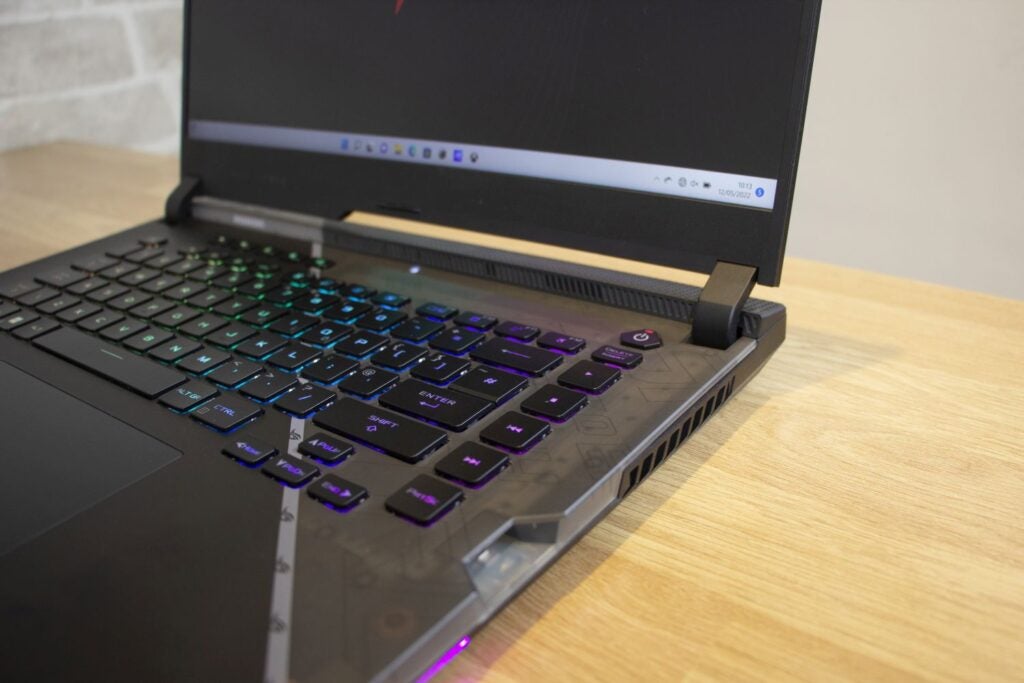
The Scar gets back on form with its keyboard. The butons have 2mm of travel, which is more than most chiclet units, and the keys have a crisp, responsive action that’s excellent for gaming. You get per-key RGB LEDs and a column of extra media keys, although there’s no number pad. The trackpad is fine, but any keen gamers should use a USB mouse instead.
The slimmer Alienware x15 is a worthwhile rival thanks to it’s got a card reader, great keyboard and the inclusion of a webcam. The Razer also goes further than the Scar in some areas, with more USB-C and Thunderbolt ports and a webcam.
Screen
- The 240Hz refresh rate and 2560 x 1440 resolution will sate most gamers
- Quality is consistently impressive, with good accuracy and contrast
- Rivals offer 360Hz options for eSports
The Asus ROG Strix Scar 15’s 15.6-inch IPS display combines a 2560 x 1440 resolution with a 240Hz refresh rate. Those are good figures: the resolution is crisper than the average 1080p display, and the refresh rate will sate anyone except people at the bleeding edge of eSports competition. The Alienware and Razer models at this price have that same basic specification.
Quality levels are terrific, too. By using a coloromiter, I found the peak brightness level to be 324 nits, handling any indoor situation and most outdoor environments, and the black point to be 0.28 nits, which is deep enough to provide ample depth.
The contrast ratio of 1157:1 delivers enough punch to make games look vibrant, and the delta E of 2.4 ensures solid colour accuracy. The panel renders 99.6% of the sRGB gamut and 97.2% of the DCI-P3 colour spaces, so it’ll produce any colour that games need.
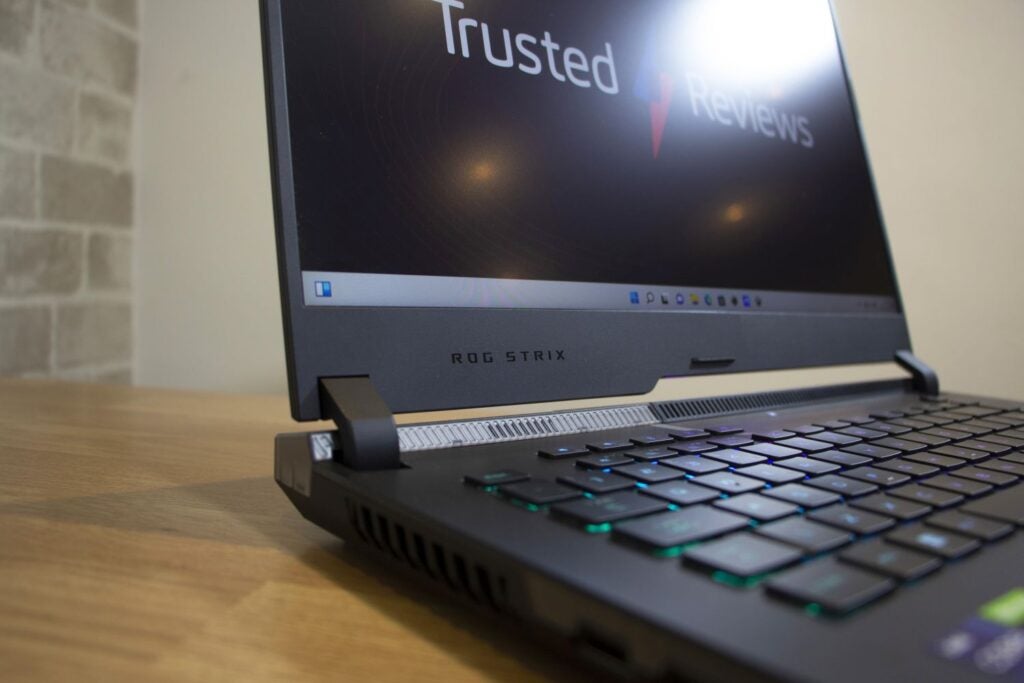
The Scar’s display is impressive, but its rivals do go further, albeit at higher prices. The Alienware is available with a 360Hz/1080p panel that costs $2599 / £2649 / €2999 if you stick with the RTX 3070 Ti. Razer also offers 360Hz screens from $2999 / £3099 / €3299.
If you want to play top-end esports titles at 360Hz, the Alienware and Razer machines are both worth consideration, and it’s a shame that the Scar 15 doesn’t have that upgrade. The only option is a 300Hz variant that’s available in some countries.
The audio gear is decent – the speakers are loud and have loads of bass, so games sound bombastic. That said, a little more balance would be preferable.
Performance
- Good gaming speed, with more grunt available in Turbo mode
- No serious thermal or noise issues
- Enough CPU power for any everyday task
The Asus ROG Strix Scar 15 packs an RTX 3070 Ti, which has its usual 5,888 stream processors and8GB of memory, while its TDP of 125W can hit 150W with Dynamic Boost. Those power figures sit right at the top of this GPU’s thermal envelope. The Intel Core i9-12900H processor has six Hyper-Threaded P-Cores that peak at 5GHz and eight slower, efficient E-Cores.
That’s a great start for any laptop, and the Scar’s hardware is bolstered with 16GB of 4800MHz DDR5 memory and a 1TB Samsung SSD with lightning-quick read and write speeds of 6961MB/s and 5074MB/s respectively.
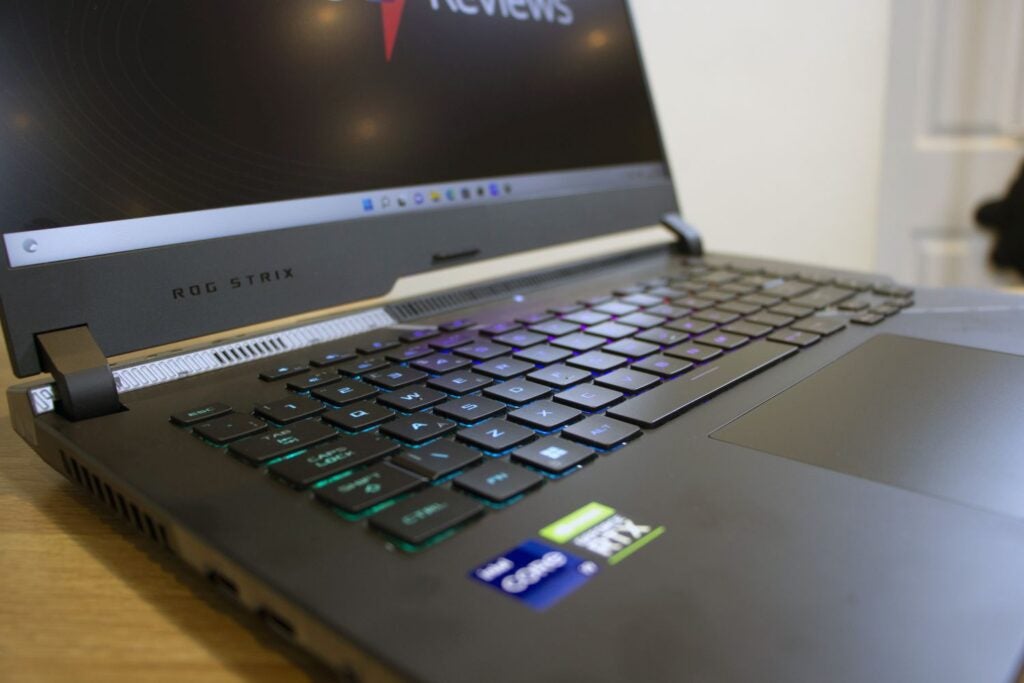
Unsurprisingly, the Asus delivered impressive benchmark results. It ran Horizon Zero Dawn in 1080p at a 96fps average and rattled through the 2560 x 1440 test at 80fps. It played Borderlands at 80fps and 62fps at those same resolutions. This laptop will play any single-player game with ray tracing and DLSS. The Scar’s average of 185fps in Rainbow Six at 1440p is quick, and ensures that this laptop will cope with any 240Hz esports situation.
It should be noted that the Scar’s scores don’t always able to outpace the Alienware, which achieved similar pace in Horizon, Borderlands and Rainbow Six with its RTX 3070.
Those scores are explained by the Asus’ performance modes: by default this laptop doesn’t use all of its power. However, deploying the Turbo setting made a big difference, adding four frames to the Horizon result and improving its Borderlands performance by eight frames. The machine’s 3D Mark Time Spy score jumped from 10389 to 11006, so you’re clearly getting a bit boost.
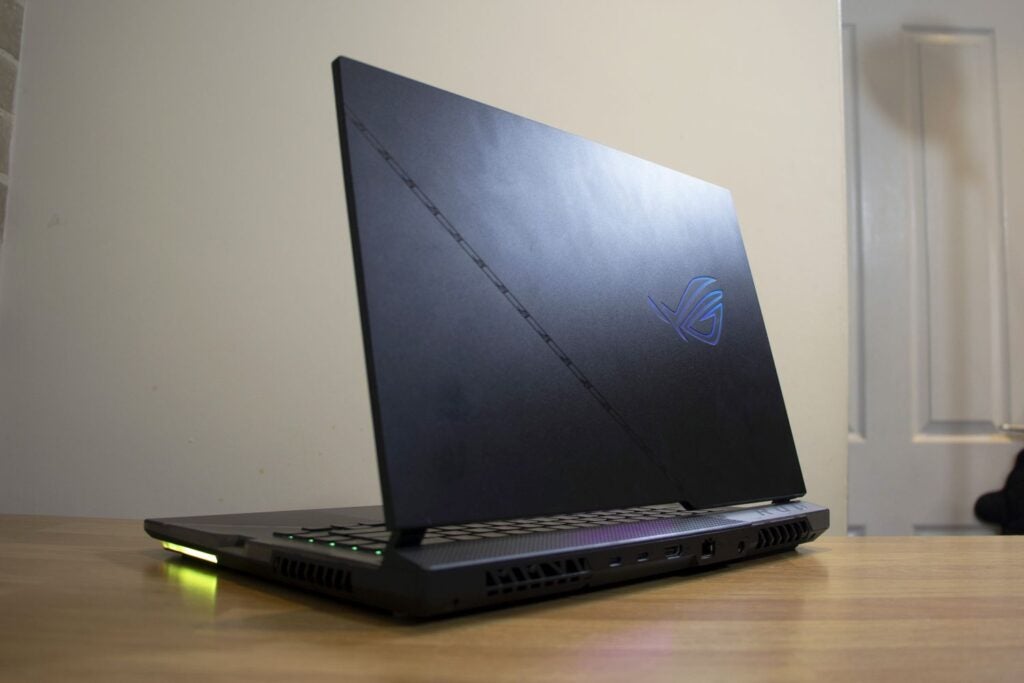
Running the Scar in Turbo mode does create extra noise, and the Asus is not quiet – but it’s no louder than its rivals, and a headset handles the noise. The Scar made less noise in its default mode, so that’s ideal if you want to reduce output, and the rig’s Quiet option kept games at a playable 60fps while drastically cutting down the fan racket. The Scar never had any external temperature issues.
If you’d like a graphics upgrade, then Asus sells a Scar 15 with the RTX 3080 Ti – but that rig costs $3299 / £3299 / €3773, so it’s a huge price increase for a relatively modest jump in performance. A better upgrade could be the Asus ROG Strix Scar 17 – it’s available with the RTX 3070 Ti and 240Hz display for £2499. If you’d prefer a larger and more immersive screen, that’s a very tempting option.
The processor, meanwhile, is fast. The Core i9 chip scored 1658 and 9680 in Geekbench’s single- and multi-core tests, with those results beating the older silicon in the Alienware x15. You’ll never have issues with mainstream content-creation and multi-tasking. Its PC Mark 10 result of 7705 is also excellent, and even further ahead of older Intel CPUs.
| Asus ROG Strix Scar 15 | Alienware x15 R2 | Razer Blade 15 | |
| CPU | Intel Core i9-12900H | Intel Core i9-11900H | Intel Core i7-10759H |
| PCMark10 | 7705 | 6780 | 5405 |
| Geekbench 5 Single / Multi | 1658 / 9680 | 1610 / 9369 | 1147 / 5232 |
| GPU | Nvidia RTX 3070 Ti | Nvidia RTX 3070 | Nvidia RTX 3070 |
| 3DMark Time Spy | 10,389 | 9751 | 7687 |
That said, the i7-12800H appears in cheaper versions of the Alienware x15 and it’s only a little slower than the Core i9 chip, so that’s viable if you’d like to save cash. Sadly, the Core i7-12800H isn’t available in the Scar.
Ultimately, the Asus ROG Strix Scar 15 is a good laptop that could be even better. It’s fast, but it doesn’t deliver a huge graphical upgrade over rivals – and some of those have slimmer, sleeker designs, more ports and more versatile display options.
Battery
- Almost two hours of gaming lifespan
- Expect half a day of use in other situations
The Scar lasted for one hour and forty-seven minutes during a gaming benchmark test, which isn’t a bad result for a gaming machine – certainly longer than both rivals, and enough to get you through plenty of train journeys.
When working, the Asus lasted for just over five hours, and it nearly made it through six hours of media playback. Those are reasonable results: better than the Alienware and on par with the Razer.
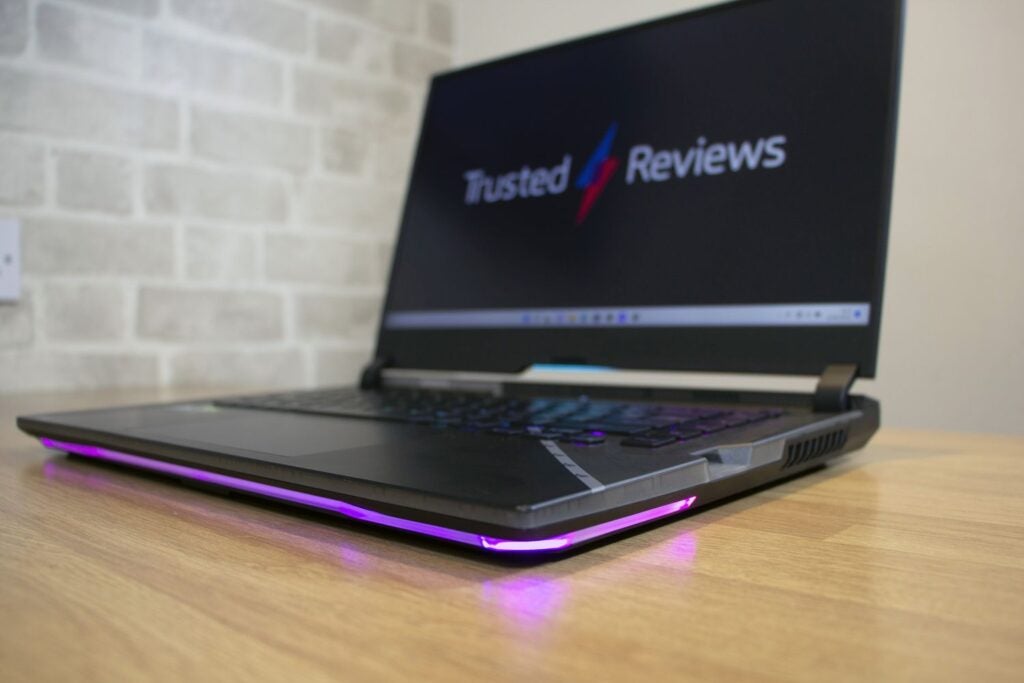
That might be decent longevity for a gaming notebook, but bear in mind that you won’t make it through a working day with the Scar, and that gaming on battery power always delivers reduced performance. As ever, you’ll get the most from this machine if you stayed plugged in.
Latest deals
Should you buy it?
You’d love a eye-catching and muscular gaming notebook
The Scar’s mix of powerful components and chunky RGB LED design mean this laptop is ideal if you want lashings of power and a design that’ll stand out.
You’d prefer something slimmer, lighter or more subtle
The Asus is not shy, and other machines balance more mature looks with sleeker builds. You’ll have to look elsewhere if you want a 360Hz display, too.
Final Thoughts
The Asus ROG Strix Scar 15 easily has the quality to handle any mainstream gaming situation, and it combines its powerful components with bold, colourful design, a great screen and a robust keyboard. That said, other machines are slimmer and more mature, with a broader range of features – so rivals deliver better balance.
How we test
Every gaming laptop we review goes through a series of uniform checks designed to gauge key things including build quality, performance, screen quality and battery life.
These include formal synthetic benchmarks and scripted tests, plus a series of real world checks, such as how well it runs when running a AAA game.
We used as our main laptop for at least a week.
Tested the performance via both benchmark tests and real-world use.
We tested the screen with a colorimeter and real-world use.
We tested the battery with a benchmark test and real-world use.
FAQs
It can, although only with 100W of power – the main power adapter supplies 280W of juice.
In many countries you’ll be lucky enough to get a backpack, headset and mouse in the box alongside an external camera.








